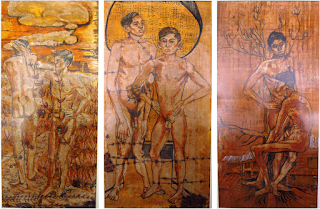Love Me in My Batik @ ILHAM
Batik is a technique. European artists were inspired by batik from Dutch colonies. Entrepreneurial Chinese immigrant fails at manufacturing batik in Malaya, but invents batik painting. Librarian becomes influential patron. Batik painting is recognised as a fine art. Batik is proclaimed as cultural heritage, and becomes the national dress. Batik painting as art medium loses relevance. And so the story goes. Joseph Tan’s iconic work, the namesake of this exhibition, portrays a mannequin-like figure undressing herself from batik cloth. The brown body is exposed, along with her inner thigh in a lighter shade. She holds up a newspaper snippet which leads to the words ‘BAT IK’ painted into the top right corner, although her back is arched upwards in a forceful pose. I stand by and appreciate its flat colours.
 |
| Joseph Tan - Love Me in My Batik (1968) |
The wicked irony in Joseph’s work is lost on the present-day viewer, although catalogue essays by Simon Soon and Farish Noor describe well the cultural patrimony, which besets batik’s status as a cultural product in this region. Historical commentaries detract from the main theme – batik painting – which pioneer Chuah Thean Teng and his heirs feature prominently in one end of the gallery. While loans from three public art institutions are a commendable practice, the quality on show is uneven, due to an inclusive intent to exhibit innovative techniques by other artists. Teng’s works hung here do not highlight his great composition skills; the crackling effect in batik paintings function only as aesthetic flourish, as I am constantly reminded of Redza Piyadasa’s comment that “(batik painting) follows the conventions of easel painting”.
 |
| 1960s - 1980s batik blocks commemorating [clockwise from top left]: The Rubber Industry; The Moon Landing; Parliament House; Malaysian Airlines System; Thomas Cup |
At the other end of the gallery, batik cop designs delight with its kitsch motifs which include the moon landing, a badminton competition, and the Malaysia Airlines logo. Abstracts by Khalil Ibrahim and Ismail Mustam display a conscious attempt at manipulating the medium’s characteristics – batik as worn fabric – although none can compare with the sensitivity projected in Patrick Ng Kah Onn’s three nude portraits. As Simon writes in the brilliant essay Fabric and the Fabrication of a Queer Narrative, “(h)ere the signifier of batik as cloth, as covering, is subverted by bringing the nude body and the batik cloth together, and in exposing the tension between the nude and the clothed, Patrick Ng had also collapsed these two registers of the body. Such a collapse suggests an expression of anxiety.”
 |
| Patrick Ng Kah Onn (1962) [from l to r]: Perpisahan (A Separation); Youth Embarbed; Pohon (A Tree) |
Lee Kian Seng’s “Yin-Yang Series – Soul and Form” shows nude bodies and Japanese images, which coalesce into a wonderfully erotic series of four pictures. A different form of agitation manifests in three works from Yee I-Lann’s “Orang Besar” series, which print juxtapositions of plants with humans in absurd postures. One is tempted to try on these kain panjang and complete the subversive gesture, although probably an inappropriate attire for formal functions… Her waxed-off words cover a black cloth hanging downstairs, the brainstorm record fitting in among other creative approaches employed by Indonesian artists. Bambang ‘Toko’ Witjaksono exploits the flatness of batik painting to create a whimsical four-panel comic strip, while Eko Nugroho’s series of grotesque headwear depict Javanese politicians as an ugly lot.
 |
| Yee I-Lann - The Orang Besar Series - Kain Panjang with Parasitic Kepala (2010) |
Looking at Fatimah Chik’s superb “Nusantara” batik cop creation, it appears that this exhibition has gotten lost within its own curatorial narratives. On one hand, its title – represented by Joseph Tan’s seminal work – refers to the cultural patrimony attached to batik cloth. On the other, it aims to trace the evolution of batik as a (once-popular) Malaysian fine art form, beginning with Teng’s batik paintings. A chronological progression ties these two disparate strands together, implying that batik works were popular for four decades because modern art collectors felt an affinity to batik as national dress, which seems implausible. The exhibition satisfies sufficiently as an educational walkthrough, although videos about the batik painting process are lacking. Leaving the show, I am further convinced why batik works seldom appeal to me...
 |
| Fatimah Chik - Rentak Nusantara (1981) |
“Firstly, batik painting has been, right from the start, an artistic expression that tries to blend divergent aesthetic traditions and expressions. Cultural patrimony is an idea that is already foreign to the particular character of batik painting. Secondly, the first practitioner of batik painting is Chuah Thean Teng, an émigré Chinese artist. The medium of batik painting has never been able to claim it has origins with any particular culture or ethnicity. Thirdly, even if we were to assume for a moment that there are certain discernible cultural precedents to Malayan batik painting, i.e. batik, where would they lie? The roots of batik in Malaya have traditionally been traced to Kelantan and Terengganu, but batik was introduced to Malaya only as late as the 1920’s from Indonesia. Is Indonesia or Malaya to be considered the cultural birthplace of batik?”
- A Decade of Ascendency, Wang Zineng, exhibition catalogue for “Love Me in My Batik”, excerpt from the unpublished thesis ‘Knowledge, Patronage and Malayan Iconography: Three Aspects in the Emergence of Malayan Batik Painting’, 2007
 |
| Chuah Thean Teng - Perairan Pulau Pinang (1952) |
Comments
Post a Comment